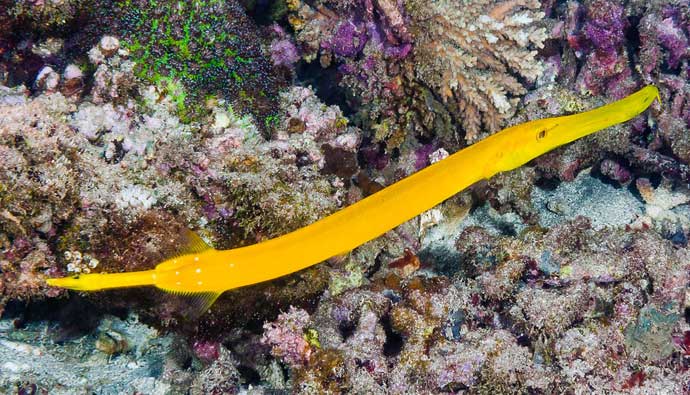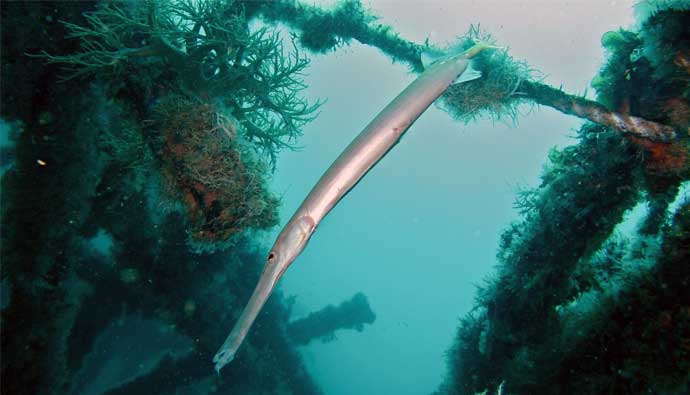If all you know about the trumpet fish is that it is a long skinny fish, you have come to the right place, angler! Find out how you can catch it and reel it in without much fuss.
Overview
There are 3 species of trumpet fish or trumpetfish. They are found in tropical waters across the globe, with 2 species in the Atlantic and one in the Indo-Pacific.
They are reef dwellers, but some prefer to remain along with rocky substrates. The body of the trumpet fish is rigid, elongated, and pike shaped, and the dorsal and anal fins lie close to the tail. It’s like the cornetfish often confuses anglers.

The fish is carnivorous and stalks its prey by hovering motionless a couple of inches above the substrate and drawing closer inch by inch. Once it is close enough, it darts in and expands its tube-like jaws in quick succession to suck in its prey. It usually feeds on smaller reef fish and crustaceans.
It’s important to note that the trumpetfish is different than the cornetfish. Although they are both long skinny fish, it’s easy to tell them apart by their tails. The trumpetfish has a rounder fan-shaped tail, whereas the cornet fish has a more pointed “T” shape.
Trumpetfish Facts
| Scientific Name | Aulostomus |
| Common Name(s) | Trumpetfish, Trumpet Fish, Atlantic Trumpetfish (Aulostomus maculatus), Caribbean trumpetfish, Chinese Trumpetfish (Aulostomus chinensis) |
| Family | Aulostomidae |
| Identifying Characteristics | The body of the trumpet fish is rigid, elongated, and pike shaped, and the dorsal and anal fins lie close to the tail. |
| Depth Range | 7 to 82 feet |
| Habitat | Can be found in tropical waters across the globe, with two species in the Atlantic and one in the Indo-Pacific |
| Limits | Check your local regulations |
Trumpetfish Habitat
This long and skinny ocean fish inhabits seagrass beds and coral reefs in shallow waters that lie in the 7 to 82 feet range in both back and fore reef zones.
In reefs, the fish can be found around areas that have several vertical structures. This includes sea whips, sponges, and sea fans, which it uses to camouflage itself.
How to Catch Trumpet Fish

Since this skinny fish prefers to remain in the shallows, the best way to catch it is via shore fishing. They are especially abundant from shore in Hawaii.
Make sure you have a 7 to 9-foot rod with a 15lb test line, and you can use both live and dead bait such as white squid. Cut that into triangles of different sizes and whip it through the water.
You can buy bait and lures from several stores you will find near the shore, so you don’t have to catch your own. Show up with your fishing gear and start angling.
Trumpet Fish Fishing Tactics
- Skim the bait across the top of the water fast before slowing it down, allowing it to sink in, and whip it again to entice the trumpet fish to bite.
- Since trumpet fish is a carnivorous reef fish, it can lead to ciguatera poisoning if consumed. Avoid that by cleaning the fish immediately after catching it.
Trumpet Fish Fishing Tips
- For this stickfish, you can find them near the mudflats past Ma’alaea Harbor on the way to Kihei.
- If you are shore fishing in Hawaii, you can fish about anywhere on Big Island to catch a trumpet fish or any other indigenous species. Don’t worry. They aren’t dangerous fish in Hawaii.
Trumpet Fish Seasons
Trumpet fish can be found year-round, but the best time to catch them is at sunrise or sunset. If you are fishing at some other time then coordinate your efforts with the tides according to the area you are in. Moving tides give the best results no matter where you are fishing in the world.
How to Clean Trumpetfish

- Wash the fish in cold water and cut the head off with a sharp knife.
- Make a cut that goes down to the belly, right through the pelvic pins, and separate them.
- Open up the cavity and pull out the innards.
- Rinse the cavity with cold water before cutting open the bladder by running the knife through it all the way to the bloodline underneath.
- Wash the cavity again to remove the blood from the bloodline and cut the fish into manageable pieces.
- Turn it around place the knife above the dorsal fin, and separate the flesh from the spin. Angle your blade downwards to feel the blade running along the spine. This will cut waste.
- Continue cutting till the fillet separates from the fish.
- Flip your knife upwards and separate the rib bones from the flesh where it meets the pin bones. Then turn the knife back and place it under the rib cage and start cutting to separate it. Remove the pin bones with a tweezer and pull towards the head to reduce damage.
- Flip and repeat on the other side to remove the other fillet.
- Remove the skin from the fillets by making a small cut between the flesh and the skin, and stop just as you reach the skin. Use a back-and-forth motion on the skin to separate it from the flesh while angling the blade till it lies flat.
How to Cook Trumpet Fish
Trumpetfish Sashimi

While trumpet fish is sold in some markets as table fare, it is not a common food fish. Most people eat it raw as sashimi using the aforementioned filleting method.
Frequently Asked Questions
Q: Why is trumpet fish confused with cornetfish?
A: Both look similar at first glance and are actually cousins. Cornetfish are usually longer, thinner, and more elongates than trumpet fish and can grow to about 2m in length. It also has a longer snout as well as distinct dorsal and anal fins. Trumpet fish are slightly different, as mentioned in this guide.
Q: What do trumpet fish eat?
A: As carnivorous reef fish, this skinny and long fish hides in plain sight preying on smaller reef fish and crustaceans.
Q: What is the coloration of the trumpet fish?
A: Trumpet fish can be bright yellow in color, but some are darker. They are also found in shades of mottled reddish-brown and green and can also change color. This proves helpful when they are hanging motionless in the water to fool prey into coming closer.
Insider Advice
The best place to fish for trumpet fish is in Hawaii, where it is called ‘nunu,’ and you can find plenty of bait in the stores along the shorelines.




 Facebook
Facebook YouTube
YouTube








